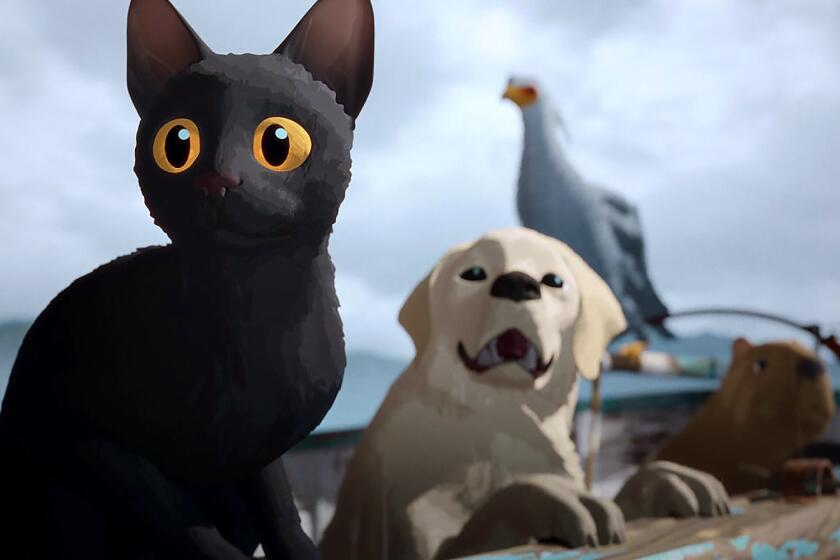Oscar Win Caps 25-Year Partnership : Animation: Aardman duo’s groundbreaking works--including ‘Creature Comforts’--highlight ‘British Invasion.’
“What happens in our films is a bit like what happens when you watch a good ventriloquist: You believe that doll on his knee is alive and speaking,” explains David Sproxton, who runs the Aardman Animations studio with his friend, Peter Lord.
“If there’s conviction behind the animation, it carries across: You believe the character on the screen, despite the fact that it’s made of balsa wood and clay, and someone’s putting words in its mouth.”
Audiences believe the Aardman characters, as the British studio produces some of the most polished and original stop-motion animation in the world. Their bizarrely imaginative video to Peter Gabriel’s “Sledgehammer” featured tap dancing chickens and mountains of moving fruit that suggested a painting by Arcimboldi.
A lisping, Brazilian jaguar complains about life within the cold confines of a London zoo in the hilarious “Creature Comforts,” which just won an Oscar for animated short film, and their commercials and shorts dominate the “British Animation Invasion” (at the Rialto and the Balboa).
The partnership that would become Aardman began in 1966, when both artists were 12. Lord’s family returned from a trip to Australia and enrolled him in a new school; the only empty seat in the classroom was next to Sproxton. The two quickly became friends, writing, drawing, getting into mischief--and making films.
“The name Aardman Animations, which we carry like an albatross, came from the first film we ever sold,” Lord sighs. “It was our first attempt at cel animation and involved a character who was bit like Superman, but quite ridiculous. He was fat and unfit, but he had a cape and trunks. We called him ‘Aardman,’ from aardvark and Superman--it wasn’t a profound idea. But the BBC bought the 15-second film, so we opened a bank account in the name of Aardman Animations, and the name stuck.”
That first sale lead the teenagers to set up their own studio. But they found traditional drawn animation tedious, and began experimenting with cut-outs and, finally, stop-motion animation of clay figures. In 1976, they moved their operation to Bristol, where they began making 30-second films for Children’s BBC involving a little clay character named Morph. (“He was a very simple figure, a bit like a British Gumby, except we didn’t know about Gumby,” Lord says.) The character proved so popular that in 1980 he was given his own series, “The Amazing Adventures of Morph,” which drew record audiences.
Sproxton and Lord eventually tired of children’s programming. They wanted to develop an adult audience for stop-motion films and use their three-dimensional techniques to create believable animated characters comparable to the ones the Disney artists had drawn. In 1982, they developed an innovative technique of animating puppet characters to spontaneous, realistic conversations, rather than prepared scripts.
Their first film using this method, “Down and Out,” focused on a homeless man trying to get a bed in a Salvation Army shelter. It impressed producer Jeremy Isaacs, who commissioned five five-minute films for the newly established Channel 4 in London. The series, entitled “Conversation Pieces” demonstrated their mastery of an intricately detailed style that’s been described as “documentary animation” and “animation verite. “
In “Late Edition,” probably the best-known film from the series, a group of journalists grumble about their daily problems as they prepare a magazine for publication. The film contains none of the wild takes and slapstick gags American audiences usually associate with animation: It’s a study of how gestures and expressions reveal individual personalities.
Traditionally, stop-motion techniques has been used for relatively crude animation, including the monsters in ‘50s horror movies like “The Beast From 20,000 Fathoms.” The Aardman animators have broken new ground, creating vivid characters, through nuances of movement and expression.
In “Next,” a puppet of William Shakespeare synopsizes 29 of his plays through mime and dance. The jaguar in “Creature Comforts” gestures expansively and furrows his brow as he gropes for the words to express his distaste for the dank British climate. A young criminal reflects on his unhappy life in “Going Equipped,” while the shadows of raindrops on a windowpane move across his face, suggesting the tears he’s unable to shed.
In conventional, drawn animation, the artists constantly check their drawings against each other to ensure the movements are smooth and correctly timed. But stop-motion animators create motions by moving the characters slightly between exposures: To produce the jaguar’s dismissive gestures, the artist had to move the figure’s paw a fraction of an inch, shoot one frame of film, re-adjust the paw, shoot another frame, and so on. There’s no way to check the movement until the sequence is completed.
“In stop-motion animation, you’re literally pushing the character into the position he needs to be in--it’s as if you’re slowing your metabolism as you perform the action,” Sproxton says. “When you’re an actor, you begin when the director says ‘action.’ You kind of run up to the bit you’re going to do and your acting inertia carries you through the role. Model animation is a bit like that: There’s a mental inertia that’s very important.”
More to Read
Only good movies
Get the Indie Focus newsletter, Mark Olsen's weekly guide to the world of cinema.
You may occasionally receive promotional content from the Los Angeles Times.










